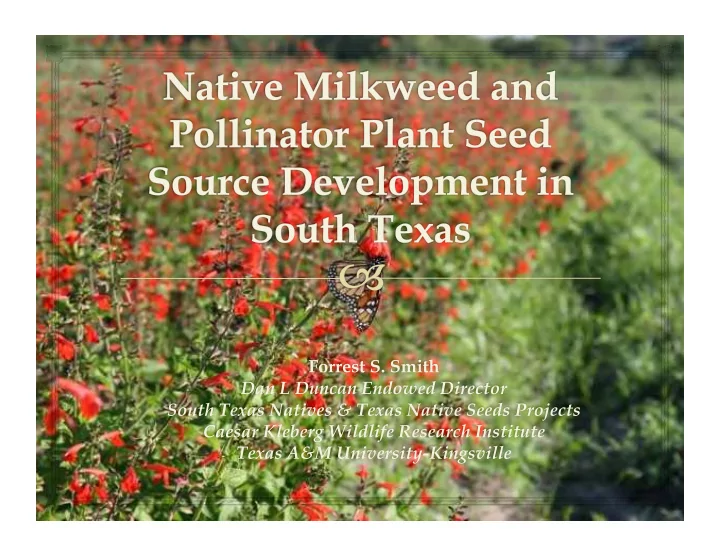

Forrest S. Smith Dan L Duncan Endowed Director South Texas Natives & Texas Native Seeds Projects Caesar Kleberg Wildlife Research Institute Texas A&M University-Kingsville
Critical Supporters Texas Department of Transportation U.S. Fish and Wildlife Services National Fish and Wildlife Foundation/Texas Parks and Wildlife Department USDA NRCS NGOs, Seed industry, landowners
Milkweed issues Scant supply of ecotypic seeds: origin of supply unknown or distant High price: $0.60 per seed=$260-$1,300 per acre Large scale markets possible, IF seed is available at reasonable cost (e.g. native seed mixes around $80/acre) (road, pipeline, and energy ROWs, agency and private land projects Many species very difficult to produce Pests 2 years to maturity Harvest and processing challenges
Milkweeds in Texas
Issues Some species are terminal in seed production One seed crop per year AND 2 years to maturity Seed germination is poor or requires stratification in some species Use of some species by monarchs is unknown Distribution is sparse or restricted to certain soils Where is restoration NEEDED to have migratory population benefit? Ex: antelopehorn and green antelopehorn milkweeds are exceptionally common throughout their range
Emory’s milkweed-rare and poorly distributed
Slim milkweed-high potential for development: but, use by monarchs is unclear…
Zizotes Milkweed
Zizotes milkweed
Percent Germination Grams of seed 100.00 100 120 140 160 10.00 20.00 30.00 40.00 50.00 60.00 70.00 80.00 90.00 20 40 60 80 0.00 0 9112642 9112641 9112632 9112628 9112619 9112618 9112637 9112639 9112635 Percent Germination 9112623 Milkweed Yield for 2016 9112640 Accession Goliad 9093331 Accession Milkweed #1 9112631 Antelope Horn 9112630 9112638 9102889 9110780 9110748 9112616 9112636 9110567 9107934 9112615 9111750 9110764 9112633 9110648
Selections 9112618/9112619-Kleberg County, TX 9093331-Cameron County, TX Southern range of plant-from soils generally targeted for restoration Areas of particularly important breeding effort Chosen based on growth form & performance Pollination and self-sterility concerns Self sterility suggested by life cycle and literature Yields and viability are good on each Grow selections together in increase
Zizotes Milkweed-Next steps Production information Seed quality (>90%) and yields (100 lbs/acre) are good Pest control for seed production is necessary 5,000 plants to Douglass King Seed Company-spring 2017 Test in actual field plantings Two-5 acre trials planted 60 acre planting in LRGV Questions: Planting rates? Cost? Effectiveness? Area of adaptation? SEED DEMAND: Will it develop? NGO’s and supportive landowners will be critical NRCS, DOT, and other large consumers can create demand
Observations Need more investment in seed source development Facilitates on-the-ground projects; many funded efforts have no seed Not just milkweeds-grasses, forbs, legumes, other plants Difficult to buy good seed mixes for pollinator habitat restoration Desired vs. available: 300 species vs. <10 species Large acre projects not possible (not enough seed) Many projects are not limited by cost; most all are limited by seed source availability in our region Seed quality Seed cleanliness
Rio Grande clammyweed-800 lbs per yr production
Awnless bushsunflower: 200 lbs annual production
Orange zexmenia: 550 lbs annual production
New species: Scarlet sage
New species: Frostweed
The preceding presentation was delivered at the 2017 National Native Seed Conference Washington, D.C. February 13-16, 2017 This and additional presentations available at http://nativeseed.info
Recommend
More recommend